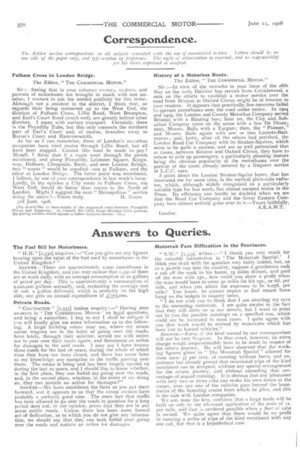Correspondence.
Page 16

If you've noticed an error in this article please click here to report it so we can fix it.
The Editor one side of invites correspondence on all subjects connected vi.ith the use of conmercial mvtors. Letters should be on the paper only, and type-written by preference. The mid of abbreviation is reserved, and no responsiOility for the views expressed is accepted.
Fulham Cross to London Bridge.
The Editor, "THE COMMERCIAL MOTOR."
Sir :—Seeing that in your columns o‘vners, makers, and patrons of motorbuses are brought in touch with one another, I venture to ask the needed publicity for this letter. Although not a resident in the district, I think that, as regards their being connected up to the West End, the districts of Fulham Cross, Lillie Road, West Brompton, and Earl's Court Road (south end), are greatly behind other districts. I mean with surface transport. Certainly, there is the Piccadilly Tube, but this only connects the northern part of Earl's Court and, of course, branches away to Baron's Court and Hammersmith.
As far as I can remember, three of London's mo:orbus companies have tried routes through Lillie Road, but all have been stopped. Cannot this road be made to pay? Myself, I think that if a route went through the points mentioned, and along Piccadilly, Leicester Square, Kingsway, Holborn, Cheapside, Bank, and over London Bridge, two " wants " would be supplied—one at Fulham, and the other at London Bridge. The latter point was mentioned, I believe, by one of your correspondents in last week's issue. Lastly, in my opinion a City route to Fulham Cross, via West End, would do better than routes to the North of London. Might I suggest the next" Metropolitan " service
doing the above?—Yours truly, H. GOOD. 3rd June, 1908.
Ewe should like to have details of the sug,gcsted route between Piccadilly Circus and Kingsway. As regards the Lillie Road—Fulbaln Cross portion, the paying seritions would appear to follow tortuous streets.—En.]
History of a Motorbus Route.
The Editor," THE COMMERCIAL MOTOR."
Sir :--In view of the remarks in your issue of the 28th May on the early Daimler bus service from Cricklewood, a note on the efforts to establish a motor service over the road from Brixton to Oxford Circus might be of interest to your readers. It appears that practically five concerns failed to operate motorbuses over the road under notice. In 1904 and 1905, the London and County Motorbus Company served Brixton with a Bussing bus; later on, the City and Suburban Company came on the scene with a few De Dions; next, Messrs. Balls with a Turgan; then, the " Pioneer," and Messrs. Balls again with one or two Lacoste-Battmanna ; and, lastly, after all the others had perished, the London Road Car Company with its Straker-Squires, which seem to be quite a success, and are so well patronised that at times, between Brixton and Oxford Circus, they have to refuse to pick up passengers, a particularly pleasing feature being the obvious popularity of the motorbuses over the portion of the route already covered by a frequent service of L.C.C. cars.
A point about the London Straker-Squire buses, that has interested me for some time, is the vertical plain-tube radiator, which, although widely recognised as a particularly suitable type for bus work, has almost escaped notice in the Press. Its efficiency can hardly be doubted when we see that the Road Car Company and the Great Eastern Company have almost entirely gone over to it.—Yours faithfully, A.E.A.M.T. London.




















